If you are planning vacations in Italy and are tired of researching from different sources? Here’s a complete guide to monuments in Italy covering how to get there and around, when is the best time, things to do, wonderful museums and famous historic buildings in Italy essential things you should know for your stay in this beautiful city. Today, Italy is the most populous and biggest country in Europe. There are numerous places, attractions, landmarks and ancient monuments in Italy that are monitoring the unprecedented history of the city, and numerous developments are affirming a long-gone past. We will tell you about the Italian monuments. Some are popular and others are not; in a wide range of locales, some are monstrous and others humble, however, they are all pieces of Rome’ and Italy’s history. We have chosen here the best monuments in Italy:
List of Monuments in Italy
1. Cathedral of Santa Maria Nascente (Milan Cathedral)
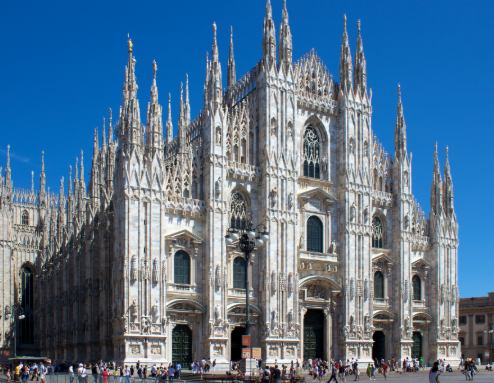
Milan Cathedral
The massive Cathedral of Santa Maria Nascente, which the Milanese call just “Il Duomo” is among the world’s largest (it holds up to 40,000 people) and most magnificent churches, the ultimate example of the Flamboyant Gothic style. The construction of this popular monument in Italy was begun in the 14th century, but its façade was not completed until the early 1800s, under Napoleon. The roof is topped by 135 delicately carved stone pinnacles and the exterior is decorated with 2,245 marble statues. The stained-glass windows in the nave (mostly 15th-16th centuries) are the largest in the world; the earliest of them are in the south aisle. Highlights include the seven-branched bronze candelabrum by Nicholas of Verdun (c. 1200) in the north transept, the 16th-century tomb of Gian Giacomo Medici, and the jeweled gold reliquary of San Carlo Borromeo in the octagonal Borromeo Chapel leading off the crypt. The choir has deeply carved panels behind the high altar, and misericords under the seats.In the south, sacristy is the treasury with gold and silver work dating from the fourth to the 17th century. A walk on the roof of the cultural monument in Italy is an impressive experience, offering views across the city and extending on clear days to the snow-covered Alps. At the front of the Duomo, near the central doorway, you can descend under Piazza del Duomo into the foundations of the Basilica di Santa Tecla (fourth-fifth and seventh century) and the fourth-century baptistery, Battistero di San Giovanni alle Fonti, which were discovered during the construction of the Milan Metro system.
Address: Piazza del Duomo, Milan.
Read More: Monuments in Bulgaria
2. Negozio Olivetti
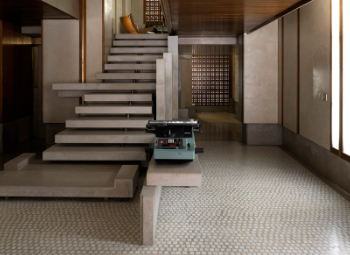
Negozio Olivetti
Constructed in 1958 on Piazza San Marco, this architectural delight was created by Carlo Scapa who was commissioned by Adriano Olivetti to convert a petite souvenir shop into an exhibit for typewriters, calculators and other related computing machines. It took Carlo two years to create such a space which is just right enough to display the materials by Olivetti. It is also home to the most antique Ettore Sottsass-designed Valentine typewriter.Today, this historical monument in Italy attracts a lot of visitors owing to not just Olivetti’s collection but the intricate designing of the building that boasts of black slab-marble fountain, coloured Murano glass–tiled floors, white-marble stairway and the teak-wood balcony.
Address: Negozio Olivetti, Venice, Italy.
3. Colosseum
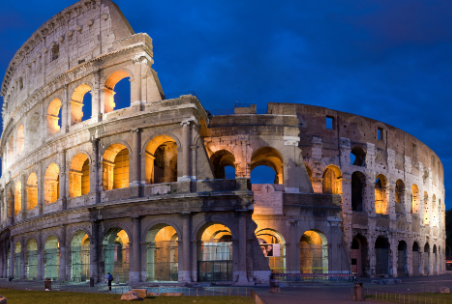
Colosseum
This enormous stone structure and monument in Italy was once the venue for gladiator fights, prisoner executions and exotic animal exhibitions in the ancient times. More than 2000 gladiators were killed when the emperor Titus started the 100 days of games. For several years, the Colosseum entertained the Romans, 2000 years later, this imposing structure still stands after earthquakes and bombings. The Colosseum is also called the Flavian Amphitheatre, every year, about six million people visit this iconic building because it is a symbol of Rome. Such as the Basilica di San Clemente, Basilica di San Pietro in Vincoli and Arch of Constantine, Colosseum is also close to other popular attractions in Rome.
Address: Piazza del Colosseo, Rome, Italy
4. Leaning Tower of Pisa
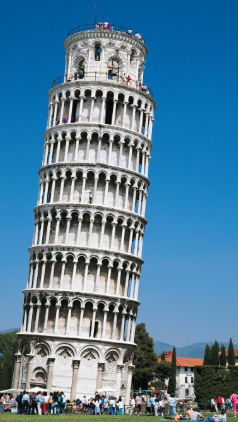
Leaning Tower of Pisa
Often called the ‘bell tower’ and campanile, the Leaning Tower of Pisa is not just an attraction but an iconic representation of the city on the world map. Known worldwide for its accidental, yet admirable tilt, the tower is also part of the four buildings of the cathedral complex in Pisa. The tilt was caused due to the soft ground on which it was constructed, which was unable to support the weight of the entire structure, resulting in the monument being slanted. This famous monument in Italy took 200 years to complete the construction of this tower and construction began in 1173. However, there is a huge debate over its architecture. Standing tall at 55.86 metres one side and 56.67 metres on the other side, this tower weighs approximately 14,500 metric tons. Spread across eight stories, the tower has a 294/296-step spiral staircase which you can climb to reach the top. At the top is the bell chamber along with 16 arches. It will take you at least 2 hours to visit this stunning masterpiece that attracts visitors from different parts of the world.
Address: Piazza del Duomo, 56126 Pisa, Italy.
Read More: Monuments of Zurich
5. Bridge of Sighs

Bridge of Sighs
Bridge of Sighs in Venice was crafted in 1600 by Antonio Contin. He is also known for designing one of Venice’s other top sights, the Rialto Bridge. This unique monument in Venice is a small distance from the Piazzo San Marco and joins the Prigione Nuovo (It is a new prison) with the Doge Palace. This former jail is in actuality the earliest construction in the globe that was individually created to attend as a prison. The Bridge of Sighs used as a medium of transfer for prisoners to the offices of inquisitors where they kept on trial. It was granted this title because, as per the tradition, the defendants sighed when they were watching the external world for the last time by a small windowpane on the bridge.
Address: Bridge of Sighs, Venice Italy.
6. Teatro Marcello

Teatro Marcello
The Theatre of Marcellus was an ancient open-air theatre that inspired from the Colosseum. However, the Colosseum is a circular auditorium while the Teatro Marcello is a semi-circular theatre. Originally this old monument in Italy was commissioned by Julius Caesar, who was murdered before its construction began and finished by Emperor Augustus in 11BC. It was named for his nephew, Marcus Claudius Marcellus, who died at the age of 19, five years before it was finished. It is located near the Tiber River, it could hold up to 20,000 visitors at a time and was a fabulous structure at its time. With columns, ramps, arches, and tunnels, it shows the finest ancient Roman skill and artistry.
Address: Via del Teatro di Marcello, 00186 Roma RM, Italy
7. Piazza San Marco
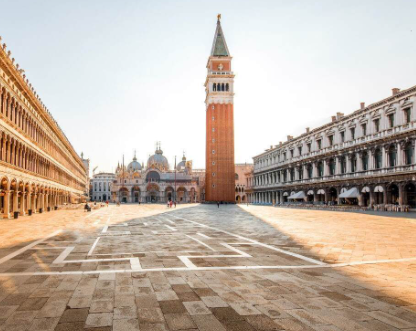
Piazza San Marco
The vast expanse of Venice’s largest square is made to seem almost intimate by the elegant uniformity of its architecture on three sides. This important landmark in Italy is loved and considered as Venice’s living room, the place everybody gathers, strolls, drinks coffee, stops to chat, tour guides and meets friends or just passes through on the way to work or play. You see here the three sides are framed in arcades, beneath which are fashionable shops and even more fashionable cafes. The open end is bookmarked by the erratic, exotic curves, swirls, mosaics, and lacy stone filigree of St. Mark’s Basilica.
The Piazza San Marco has been the city’s main gathering place for centuries, as the only public square in Venice. Piazza San Marco is surrounded by landmark attractions, open-air cafés and, including San Marco Basilica and the Palazzo Ducale, it’s the natural epicenter for any visit to the City of Canals. The square is actually laid out in a trapezoid shape that widens as it approaches the basilica. Despite the crowds that throng it in summer and the rains that flood it in winter, St. Mark’s Square offers a memorable Venetian experience in every season.
Address: Piazza San Marco, Venice, Rome.
Read More: Monuments of Botswana
8. Camposanto

Camposanto
A cemetery known by the name of Campo Santo, Camposanto Monumentale or Camposanto Vecchio is situated on the northern side of Pisa’s Cathedral Square. It is now addressed as monumental as recently an urban cemetery was constructed in Pisa. To avoid confusion, this one is often called the Camposanto Monumentale. A burial ground, legend says that any person’s body buried in this ground will decay within 24 hours.
The building of this structure was constructed by the famous Giovanni in 1278 over the burial ground. The exterior wall of the building has 43 blind arches and two doorways. The right side door has an artwork exhibiting the Virgin Mary with Child and four saints. It has three chapels- Ammannati (named after a teacher in the University of Pisa), Aulla (that houses the original lamp seen by Galileo) and Dal Pozzo (where at times a Mass is organised).
Address: Piazza del Duomo, Pisa, Italy.
9. Ara Pacis

Ara Pacis
Because it fuses new and old in a truly innovative way, the contemporary Ara Pacis Museum is a fascinating sight. The museum’s unique structure was designed by American architect Richard Meier in 2006 to act as a home for a single (but exquisite) ancient altar. Dedicated to Pax, the Roman goddess of Peace, the elaborately carved marble structure was once part of a massive complex. Built-in 13 BC to mark the return of the Emperor Augustus to Rome, the altar was reassembled in its current location near the Tiber River in 1938. Since the end of the Fascist era, this heritage monument in Italy was the first architectural space to be built in the historical centre of Rome.
Address: Lungotevere in Augusta, 00186 Roma RM, Italy
10. Rialto Bridge
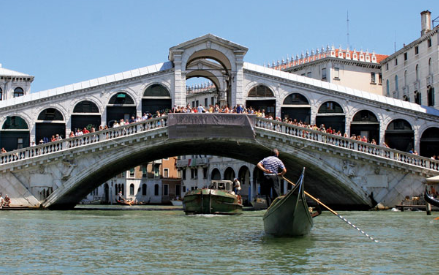
Rialto Bridge
The Rialto bridge is one of the oldest bridges across the Grand Canal, Venice. This amazing bridge existed as a wooden pontoon structure from as early as the 12th century. Due to increasing boat traffic, it was replaced by a drawbridge less than a century later. very few of us know the wooden version was destroyed including being burned during collapsing during a boat parade. Then in 1551, the city government opened a competition for rebuilding the bridge using durable stone.
Many architects participated in this competition including Michelangelo and Palladio. Antonio Da Ponte was the winner, however, and in typical Venetian style, the winning design was quite similar to what was there previously. This beautiful monument in Venice is now the hub of the visitors and tourists who flock to the lovely bridge for picturesque photographs with the Grand Canal, with mass tourism peaking in recent years.
Address: Rialto Bridge, Venice, Italy.
Read More: Monuments in Brunei
11. St. Peter’s Basilica

St. Peter’s Basilica
St. Peter’s Basilica is a place where Saint Peter, one of Jesus’ disciples, was buried in 64 A.D. It is one of the holiest temples in Vatican City. Inside the Basilica are important works of art from Carlo Maderno, Bramante, and Michelangelo. This religious monument in Italy is an enormous church that can accommodate 20,000 people. Completed in 1614, the Dome is an incredible piece of architecture. You’ll get a stunning view of St. Peter’s Square when you climb right to the top. Include the Sistine Chapel and Vatican Museums nearby places that you can also visit.
Address: Piazza San Pietro. Vatican City, Rome.
12. Ca’ d’Oro
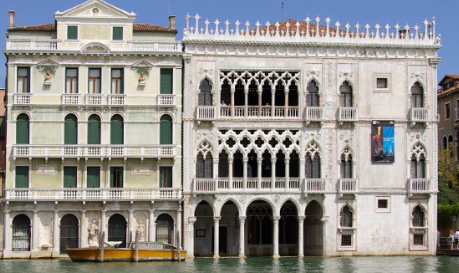
Ca’ d’Oro
The delicate marble filigree by Bartolomeo Bon seems too lace-like to be carved of stone, and you can only imagine the impression this façade must have made covered in its original paint and gold. Bartolomeo Bon created Porta Della Carta in the Palazzo Ducale, along with it. This old monument in Italy is considered the most perfect example of Venetian Gothic. You can appreciate the interior, too, as this palazzo is now an art museum, restored to provide both a setting for the artworks and a look at the way wealthy Venetians lived in the 15th and 16th centuries. The connoisseur responsible for saving the Ca’ d’Oro, Baron Giorgio Franchetti gave his art collection to the state in 1922. He gave works by Titian, Mantegna, Van Dyck, Tullio Lombardo, and Bernini.Ca’ d’Oro is now the hub of the visitors and tourists who flock to the lovely site for picturesque photographs with these monuments, with mass tourism peaking in recent years.
Address: Ca’ d’Oro, Venice, Italy
13. Corte Suprema di Cassazione
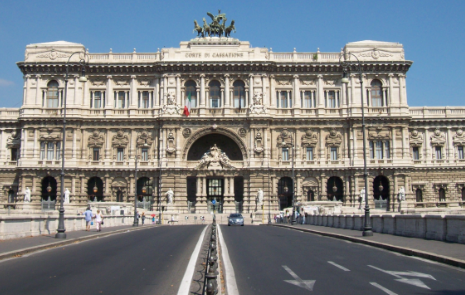
Corte Suprema di Cassazione
Right near The Vatican City, this is an amazing building. The architecture is breathtaking. Not like most of the historical areas nearby this building dates from the 1920s. Rome’s Palace of Justice, the seat of the Supreme Court of Cassation is a giant structure that dominates the banks of the Tiber River in the Prati district. It is often called “Il Palazzaccio” and its large size, beautiful decorations and lengthy construction period make it a major point of attraction. It remains one of the most visited buildings in Rome inspired by Renaissance and Baroque architecture. The Palace of Justice is a grand new building which followed the proclamation of Rome as the capital city of the Kingdom of Italy. You can get a good view of it from the bridge Ponte Umberto I or from the Piazza Cavour, so both front and back look impressive. It is completely covered with Travertine limestone inspired by late Renaissance and Baroque architecture.
Address: Palazzo di Giustizia, Piazza Cavour, 00193 Roma RM, Italy.
14. Torre dell Orologio

Torre dell Orologio
Also known as Saint Mark’s Clocktower, Torre dell Orologio is a renaissance structure that is located on the Piazza San Marco in Venice. Designed by Mauro Codussi, it is a huge tower consisting of a clock followed by buildings on either side. Dating back to the 15th century, the clock was often altered with time. The clock (in bright blue and gold colour) displays not just the time of the day but also shows the prevalent Zodiac sign of the year and the phase of the moon. Like most of the other monuments in Venice, this too is managed by Fondazione Musei Civici di Venezia. This iconic landmark in Italy stands on two floors which also forms an arch-like passage to the main area of the city.
Address: Torre dell Orologio, Venice, Italy.
Read More: Monuments of Vancouver
15. Il Vittoriano
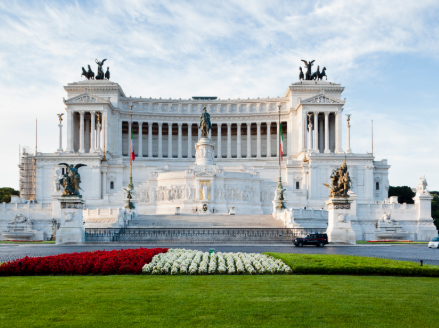
Il Vittoriano
Another building which was built between 1885 – 1925 to honor Victor Emmanuel who was the first king of Italy. This popular monument in Italy is so grandiose and ornate that it’s almost overwhelming. The tomb of the unknown soldier is sobering and almost diverts attention from the magnificent statues of horse-drawn chariots on the roof of this enormous building. The detail of the interior is incredible and the artworks are spectacular. You can also take the lift to ‘il Cielo Sopra Roma’ to see the 360-degree views over both modern and Ancient Rome. Well worth the extensive waiting time for the lift to the rooftop.
Address: Piazza Venezia, 00186 Roma RM, Italy
16. Scala Contarini del Bovolo
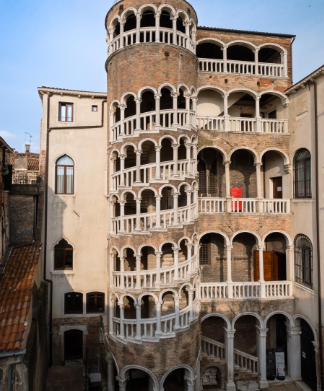
Scala Contarini del Bovolo
Although it is a palace but as of now, the only remains that are left here are the fading frescoes and the staircase. The only attraction that still draws tourists to this attraction is the outer spiral staircase of the palace. Yet another architectural marvel by ace architect Giovanni Candi, the palace was originally built for the prestigious Contarini family in the 15th century. However, it was Giorgio Spavento who incorporated the grand staircase in the year 1499.
Depicting a classic example of Renaissance and Byzantine architecture, the white colour staircase looks exactly like one of the scenes from Shakespeare’s romantic novel. Located close to the Rialto Bridge, in the back alley, this iconic monument in Italy has many arches and as you reach at the top of it, it offers a panoramic view of the Venice city. Make sure you reach here by afternoon if you wish to climb the stairs as you can only take the stairs before 4 pm.
Address: San Marco 2906, 30124 Venice, Italy.
17. Pantheon

Pantheon
It is believed that the extraordinary architecture of Pantheon is more than 2000 years old. As a temple for the Roman gods it was built by the Roman Emperor Hadrian. Along with famous Renaissance painters, Great Italian kings and Raphael are buried in the Pantheon. For thousands of years, the dome and its most fascinating aspect stand tall without any damage. Architects today are still in amaze because of its construction. Its interiors are shaped as a cylinder with no windows and just the hole on the top, which is called the eye of the Pantheon or the Oculus. The architecture of this ancient monument in Italy is one of the best-preserved buildings from Ancient Rome.
Address: Piazza Della Rotonda, Rome, Italy.
Read More: Monuments in Bosnia
18. Scuola Grande Dei Carmini

Scuola Grande Dei Carmini
One of the religious monuments in Italy, Scuola Grande Dei Carmini is also home of the Venetian Scuola. Designed by Baldassare Longhena and Francesco Caustello, this school of charity is dedicated to Our Lady of Mt. Carmel. Today, the chapel has a wooden roof along with an altarpiece of the Virgin of the Carmelo. The building also boasts wall paintings by Giustino Menescardi including Martyrdom of Brothers Maccabe and Abigail placates David’s designs against her husband Nabal. The interiors of the building are quite extravagant. While you are here, don’t miss seeing the gold-leafed stucco stairway to heaven and the nine-panel ceiling of a rosy Virgin in Glory. The building was also home to some wandering travellers during the 13th century but today the building is host to some of the concerts and often organises charity works.
Address: Dorsoduro, 2617, Venice, Italy
So far we have discussed the best monuments in Italy, which contains the proper information regarding all the most visited monuments in Italy. I hope you might have loved reading this article and if you love to know more about Italy then kindly head to our other articles as well which will help you to get knowledge about.
The post Most Visited Monuments in Italy l Famous Monuments in Italy appeared first on World Tour & Travel Guide, Get Travel Tips, Information, Discover Travel Destination | Adequate Travel.